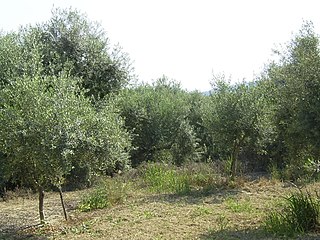Related Research Articles

The Kingdom of Thessalonica was a short-lived Crusader State founded after the Fourth Crusade over conquered Byzantine lands in Macedonia and Thessaly.

The Battle of the Olive Grove of Kountouras took place in the summer of 1205, in Messenia in the Morea peninsula, between the Frankish Crusaders and the local Byzantine Greeks, resulting in a victory of the Franks and the collapse of the local resistance.

William I of Champlitte (1160s-1209) was a French knight who joined the Fourth Crusade and became the first prince of Achaea (1205–1209).

Skorta was a name used in the 13th and 14th centuries, during the period of Frankish rule in the Peloponnese, to designate the mountainous western half of the region of Arcadia, which separated the coastal plains of the western (Elisian) and southwestern (Messinian) Peloponnese from the Arcadian plateau in the interior. The name is found chiefly in the various-language editions of the Chronicle of the Morea. It also appears as Skodra and Skorda, in the chronicle of Pseudo-Dorotheos of Monemvasia.

Florent of Hainaut was Prince of Achaea from 1289 to his death, in right of his wife, Isabella of Villehardouin. He was the son of John I of Avesnes and Adelaide of Holland. From his father he received the stadholdership (government) of Zeeland.

Othon de la Roche, also Otho de la Roche, was a Burgundian nobleman of the De la Roche family from La Roche-sur-l'Ognon. He joined the Fourth Crusade and became the first Frankish Lord of Athens in 1204. In addition to Athens, he acquired Thebes by around 1211.
Nicholas III of Saint-Omer was one of the most powerful and influential lords of Frankish Greece. He was hereditary Marshal of the Principality of Achaea, lord of one third of Akova and of one half of Thebes. He also served on three occasions as bailli of the Principality of Achaea.
Nicholas II of Saint Omer was the lord of half of Thebes in Frankish Greece from 1258 to his death in 1294. From his two marriages he became one of the richest and most powerful barons of his time, building a splendid castle at Thebes as well as the Old Navarino castle. He also served as bailli of the Principality of Achaea on behalf of the Angevins of Naples between 1287 and 1289.
Thomas I d'Autremencourt, commonly misspelled de Stromoncourt, was the first Lord of Salona in Central Greece. A knight from Autremencourt in Picardy, he was given Salona as a fief by Boniface of Montferrat, King of Thessalonica, in 1205 during the division of the Byzantine Empire after the Fourth Crusade. Thomas extended his domain over most of Phocis, from the Gulf of Corinth to the passes of Gravia in the north and the Parnassus in the east. Ca. 1210, he tried to extend his rule westwards, and attacked the port town of Galaxidi. Its inhabitants, however, called upon the ruler of Epirus, Michael I Komnenos Doukas, for aid. The Epirote army attacked and captured Salona, with Thomas himself falling in battle. As the Epirote ruler was pre-occupied elsewhere, however, his occupation did not last long, and within a few years Thomas's son, Thomas II, was able to reclaim Salona.
Bela of Saint Omer was a French knight, descended from a Fauquembergues family who were castellans of the eponymous castle of Saint-Omer.
Otho of Saint Omer was the lord of half of Thebes in Frankish Greece from 1294 to ca. 1299.

John of Saint Omer was baron of a third of Akova and marshal of the Principality of Achaea.
Berthold II von Katzenelnbogen was a German nobleman of the family of the Counts of Katzenelnbogen and a participant in the Fourth Crusade (1202–04), who became lord of Velestino (c.1205–17) and regent of the Kingdom of Thessalonica (c.1217) in Frankish Greece. He was a patron of poets and in politics a Ghibelline.
William of Saint Omer was a French knight, descended from a Fauquembergues family who were castellans of the eponymous castle of Saint-Omer.
The First Parliament of Ravennika was convened in May 1209 by Latin Emperor Henry of Flanders in the town of Ravennika in Central Greece in an attempt to resolve the rebellion of the Lombard barons of the Kingdom of Thessalonica.
Benjamin of Kalamata was the longtime chancellor of the Principality of Achaea in Frankish Greece from 1297 until at least 1324.
The Second Parliament of Ravennika was convened in May 1210 by Latin Emperor Henry of Flanders in the town of Ravennika in Central Greece in order to resolve the differences between the princes of Frankish Greece and the Roman Catholic clergy of their domains.
William V of Saint Omer was the castellan of Saint-Omer from 1192 until his death, as well as Lord of Beaurain and Fauquembergues.
William IV of Saint Omer was the castellan of Saint-Omer from ca. 1171 until his death, as well as Lord of Beaurain and Fauquembergues.
William VI of Saint Omer was the castellan of Saint-Omer and lord of Fauquembergues briefly in ca. 1246/7.
References
- 1 2 Van Tricht 2011, p. 163 (note 26).
- 1 2 Giry 1875, p. 97.
- 1 2 Longnon 1949, p. 119.
- ↑ Van Tricht 2011, p. 163.
- ↑ Longnon 1949, p. 123.
- 1 2 Bon 1969, p. 707.
- ↑ Van Tricht 2011, pp. 381–382 (note 112).
- 1 2 3 Longnon, 1946, p. 149
- ↑ mention that Nicholas died in 1212 by Perra Perra 2011 , Οικογένεια Σεντ Ομέρ probably stems from a misreading of genealogical trees derived of Hopf who mention 1212 as a year of mention in documentary evidence
- ↑ Perra 2011, Οικογένεια Σεντ Ομέρ.